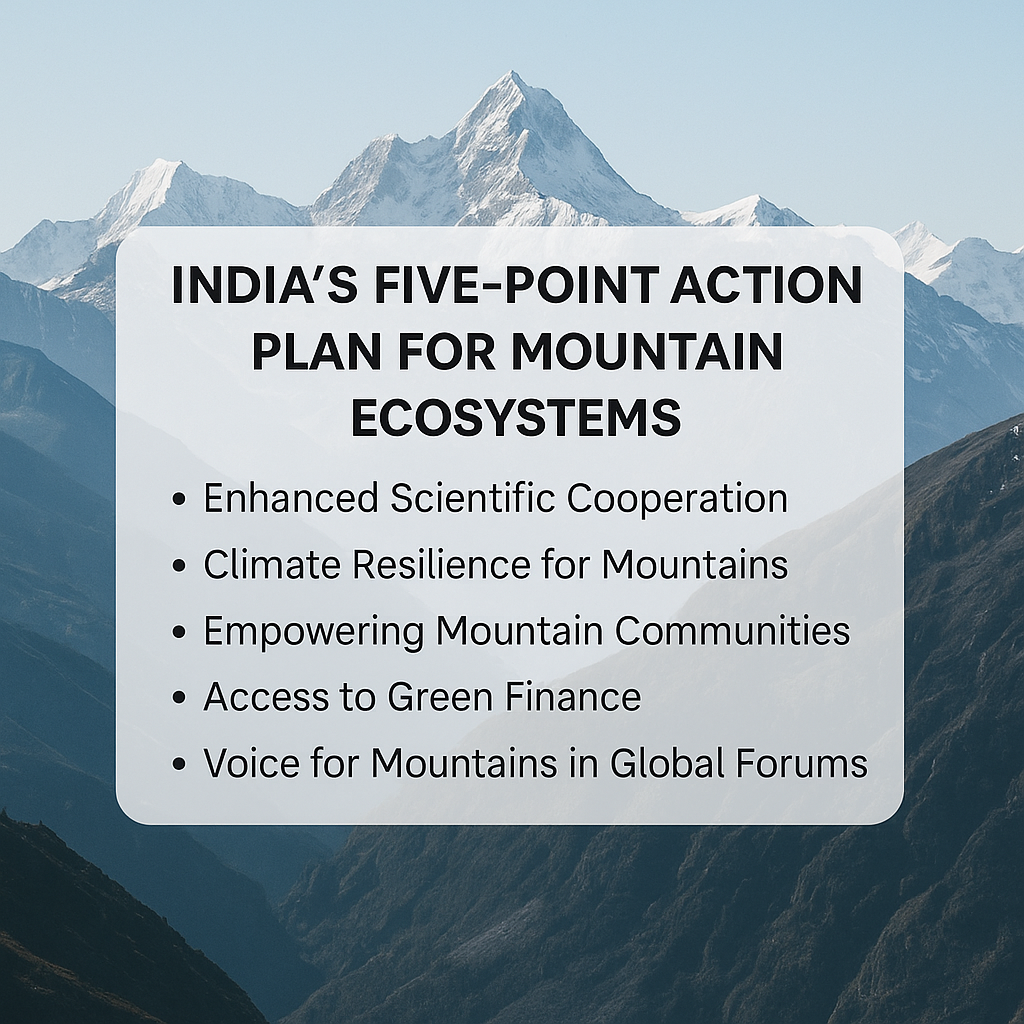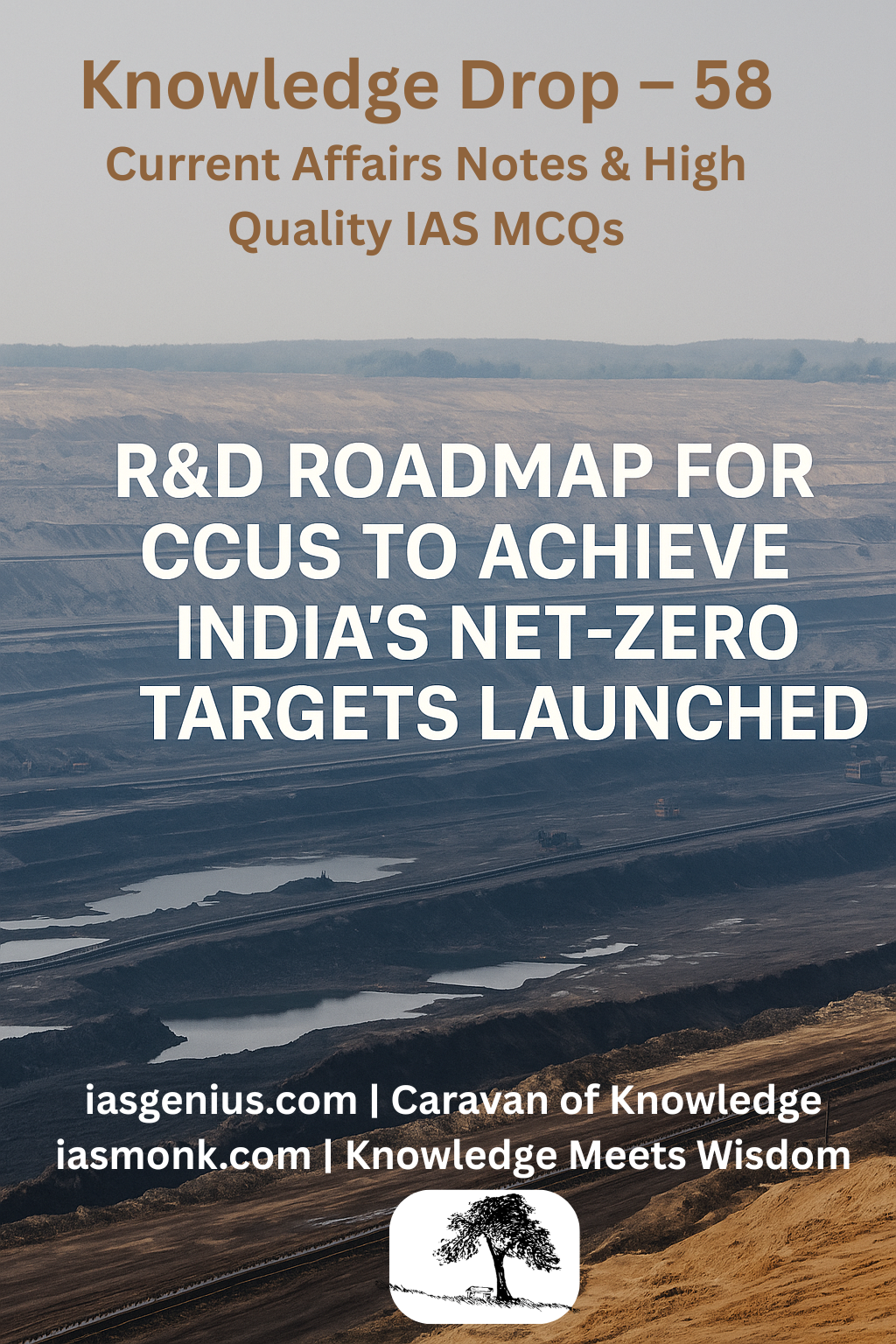
May 17, 2025, Post 2: Echoes from the Peak: India’s Call to Protect the Himalayas | High Quality Mains Essay | Prelims MCQs
Echoes from the Peak: India’s Call to Protect the Himalayas

🎯 Thematic Focus:
Environment | Himalayan Ecosystems | Climate Diplomacy | Sustainable Development
🕊️ Opening Whisper
In the silence of the snow-peaked heights, a mountain speaks not in noise, but in wisdom — if we listen before it melts.
🔍 Key Highlights:
- At the 1st Sagarmatha Sambaad in Nepal, India presented a 5-point Global Action Plan for fragile mountain ecosystems.
- Sagarmatha means “Head of the Sky” — the local name for Mount Everest — symbolizing elevation in both spirit and duty.
- Union Minister emphasized shared civilizational ties and ecological dependence across South Asia’s mountain nations.
- India highlighted the climate injustice borne by developing nations despite contributing minimally to global emissions.
- Urged developed countries to fulfill promises of climate finance, technology transfer, and capacity building.
- Pitched for regional collaboration under Project Snow Leopard and the International Big Cats Alliance.
🔬 The Five-Point Global Action Plan – India’s Proposal
- Enhanced Scientific Cooperation:
Joint research on glacier retreat, cryosphere monitoring, water cycles, and biodiversity mapping. - Climate Resilience for Mountains:
Invest in GLOF early warnings, weather forecasting, and infrastructure tailored to climate extremes. - Empowering Mountain Communities:
Respecting indigenous knowledge, promoting green livelihoods, and ensuring policy inclusion. - Access to Green Finance:
Push for equitable funding under UNFCCC-Paris norms for mountain adaptation and mitigation. - Voice for Mountains in Global Forums:
Mainstreaming mountain priorities in climate treaties and SDG negotiations.
🏔️ Concept Explainer: Why the Himalayas Are More Than Just Mountains
- Climate Regulator: They shield India from Arctic cold and attract monsoon clouds.
- River Source: Feed over a billion lives through Ganga, Indus, Brahmaputra.
- Biodiversity Ark: Habitat for snow leopards, red pandas, and thousands of unique species.
- Sacred Geography: Sites like Amarnath, Badrinath, Kailash lie in these ranges.
- Geo-Strategic Wall: Frontier with China, Nepal, Bhutan; vital to India’s defence and diplomacy.
🧩 Initiatives by India to Preserve the Himalayan Ecosystem
- National Mission on Sustaining Himalayan Ecosystem (NMSHE)
- Project Snow Leopard — Community-based big cat protection
- Secure Himalaya Project — Livelihood + biodiversity, supported by UNDP
- International Big Cats Alliance — Global Himalayan conservation diplomacy
🗺️ GS Paper Mapping:
- GS Paper 1: Indian Geography – Himalayas, River Systems, Sacred Sites
- GS Paper 3: Environment – Climate Change, Adaptation, NAPCC Missions
- GS Paper 2: International Relations – Transboundary Environmental Cooperation
✨ A Thought Spark — by IAS Monk
The Earth is not asking us to conquer mountains — only to listen to their silence and preserve their song.
High Quality Mains Essay For Practice :
Word Limit 1000-1200
The Silent Cry of the Mountains: India’s Global Call to Protect Fragile Ecosystems
Introduction
Mountains are often seen as eternal — timeless monoliths watching over civilizations. But in the era of climate change, even the great Himalayas are no longer immune. The first Sagarmatha Sambaad, held in Nepal in 2025, brought renewed focus on the vulnerability of mountain ecosystems. Representing India, the Union Environment Minister presented a five-point global action plan to safeguard these fragile regions, highlighting the shared responsibility of the global community. The dialogue — named after Mount Everest (Sagarmatha) — not only called for scientific cooperation and climate justice but also placed India’s leadership at the heart of a planetary conscience.
The Sagarmatha Sambaad: A Dialogue Beyond Borders
Derived from Sanskrit and Nepali roots, “Sagarmatha” means “Head of the Sky.” It is a symbol not just of elevation but of ecological reverence. In this spirit, India used the Sambaad to urge collective action on the following fronts:
- Scientific Cooperation: To understand glacier melt, hydrology, and biodiversity.
- Climate Resilience: Investment in early warning systems and infrastructure.
- Empowering Communities: Inclusion of indigenous voices in policymaking.
- Green Finance: Equitable access to adaptation and mitigation funding.
- Recognition of Mountain Voices: Ensuring the Himalayas are represented in global climate discourse.
This action plan stems from a recognition that mountain countries are bearing disproportionate impacts despite contributing least to historical emissions.
The Ecological Role of the Himalayas
The Himalayas are more than scenic backdrops — they are living, breathing regulators of life across South Asia.
- Climatic Regulator: Acting as a shield against icy northern winds, they influence the Indian monsoon, making them essential to food and water security.
- Water Tower of Asia: They feed the Ganga, Brahmaputra, and Indus, supporting over a billion people.
- Biodiversity Reservoir: Home to iconic species such as the snow leopard, red panda, and Himalayan monal.
- Cultural Heartland: Sacred sites — Kailash, Amarnath, Badrinath — tie these peaks to spiritual consciousness.
- Strategic Frontier: As India’s natural barrier with China, Nepal, and Bhutan, they are crucial for national security and transboundary diplomacy.
The Climate Crisis in the Cryosphere
The Himalayas are among the fastest warming regions in the world. Glacial retreat threatens to:
- Disrupt river flows
- Trigger Glacial Lake Outburst Floods (GLOFs)
- Erase biodiversity zones
- Displace traditional communities
In the absence of adaptation funding, the vulnerabilities of these regions become existential crises. India, despite limited historical emissions, is rising to the occasion — not just to defend its own terrain, but to offer a collective framework.
India’s Mountain Missions: Walking the Talk
India is not merely preaching global morality. Its domestic Himalayan programs reflect serious environmental commitment:
- National Mission on Sustaining the Himalayan Ecosystem (NMSHE)
Focuses on glacier monitoring, sustainable tourism, and conserving mountain agriculture. - Secure Himalaya Project
Supported by the UNDP, this integrates biodiversity conservation with livelihood resilience in Himachal Pradesh, Ladakh, Sikkim, and Uttarakhand. - Project Snow Leopard
Protects high-altitude fauna and habitats using community involvement and scientific tracking. - International Big Cats Alliance (IBCA)
India-led diplomatic initiative for cross-border species like the snow leopard, tiger, and leopard — reinforcing ecological sovereignty.
These programs represent India’s fusion of development and conservation, placing people and planet in tandem.
The Moral Politics of Climate Justice
India’s statement at Sagarmatha Sambaad also reiterated a critical truth:
South Asia contributes less than 4% to historical CO₂, yet it faces some of the harshest climate consequences.
Rich nations have under-delivered on climate finance and technology transfer. Without adequate support, mountain nations like Nepal, Bhutan, and India may lose more than glaciers — they risk losing culture, community, and continuity.
India’s leadership thus expands the climate justice narrative beyond mitigation to adaptation and representation. By voicing mountain concerns in global negotiations, India is helping restructure the ethical priorities of the climate movement.
Conclusion
Mountains are resilient, but they are not invincible. The Sagarmatha Sambaad, and India’s five-point roadmap, remind us that climate solidarity must include altitude equity — ensuring that the higher you go, the harder you are heard.
In listening to the cry of the Himalayas, India is not just protecting its geography — it is defending the soul of South Asia. If we succeed, the Himalayas will not just survive — they will continue to inspire.
Target IAS-26: Daily MCQs :
📌 Prelims Practice MCQs
Topic:
MCQ 1 – Type 1: How many of the above statements are correct?
Consider the following statements regarding the Sagarmatha Sambaad and India’s environmental commitments:
1)India’s Five-Point Action Plan includes green finance, scientific cooperation, and community empowerment.
2)Sagarmatha is the Sanskrit word for the Indian Ocean.
3)The Secure Himalaya Project is implemented with support from the UNDP.
4)India’s Project Snow Leopard is focused only on the Western Ghats.
Which of the above statements are correct?
A) Only two
B) Only three
C) All four
D) Only one
🌀 Didn’t get it? Click here (▸) for the Correct Answer & Explanation
✅ Correct Answer: A) Only two
🧠 Explanation:
Correct Answer: A) Only two
1.✅ True – India’s Five-Point Plan includes these key pillars for mountain ecosystem protection.
2.❌ False – Sagarmatha is the Nepali name for Mount Everest, not the Indian Ocean.
3.✅ True – The Secure Himalaya Project is backed by UNDP.
4.❌ False – Project Snow Leopard targets high-altitude Himalayan regions, not the Western Ghats
MCQ 2 – Type 2: Two-statement check
Consider the following two statements:
1)The Himalayas regulate the Indian monsoon and serve as the source of major South Asian rivers.
2)India’s defence exports were a key focus area of discussion at the Sagarmatha Sambaad.
Which of the above statements is/are correct?
A) Only 1 is correct
B) Only 2 is correct
C) Both are correct
D) Neither is correct
🌀 Didn’t get it? Click here (▸) for the Correct Answer & Explanation
✅ Correct Answer: A) Only 1 is correct
🧠 Explanation:
Correct Answer: A) Only 1 is correct
1.✅ True – Himalayas play a vital role in weather patterns and water security.
2.❌ False – Defence exports were not discussed; the focus was on climate and ecology.
MCQ 3 – Type 3: Which of the following statements is/are correct?
Consider the following with respect to India’s mountain ecosystem initiatives:
1)The NMSHE is a part of India’s National Action Plan on Climate Change (NAPCC).
2)The International Big Cats Alliance promotes conservation across borders for species like snow leopards.
3)The Himalayas are culturally significant to both Hinduism and Buddhism.
4)Sagarmatha Sambaad is held annually in Bhutan as part of India’s regional climate diplomacy.
Select the correct code:
A) 1, 2 and 3 only
B) 2 and 4 only
C) 1, 2 and 4 only
D) 1, 2, 3 and 4
🌀 Didn’t get it? Click here (▸) for the Correct Answer & Explanation
✅ Correct Answer: A) 1, 2 and 3 only
🧠 Explanation:
Correct Answer: A) 1, 2 and 3 only
1.✅ True – NMSHE is one of eight missions under the NAPCC.
2.✅ True – The IBCA aims at collaborative conservation of big cats.
3.✅ True – The Himalayas hold sacred status in both religions.
4.❌ False – The event was hosted by Nepal, not Bhutan.
MCQ 4 – Type 4: Direct factual
Which of the following best describes the objective of Project Snow Leopard?
A) Promotion of winter tourism in Himalayan states
B) Conservation of endangered high-altitude species through community-based efforts
C) Preventing forest fires in the Western Himalayas
D) Monitoring seismic activity in the Himalayan tectonic zone
🌀 Didn’t get it? Click here (▸) for the Correct Answer & Explanation.
✅ Correct Answer: B) Conservation of endangered high-altitude species through community-based efforts
🧠 Explanation:
Correct Answer: B) Conservation of endangered high-altitude species through community-based efforts
1.✅ Project Snow Leopard blends science and local knowledge to conserve biodiversity in India’s trans-Himalayan regions.


















